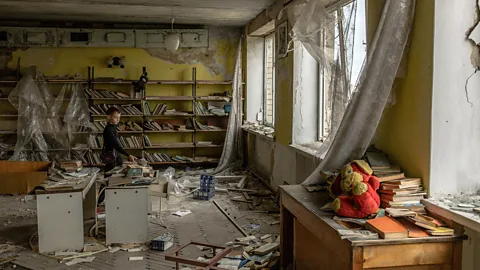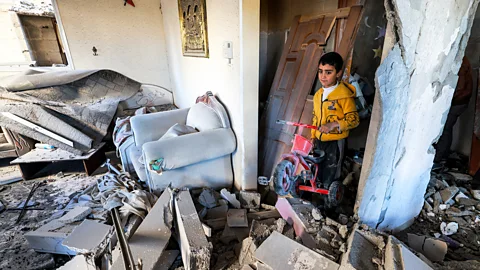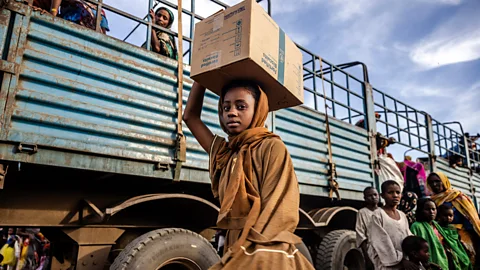Many children must live with the trauma of war. Here's how to help them
 Getty Images
Getty ImagesConflict in Ukraine, Gaza and Sudan has led to millions of children losing family members, fleeing their homes and being caught up in the fighting themselves. The effects could last for decades.
When the Bosnian war broke out in 1992, Selma Baćevac was a seven-year-old in Sarajevo. Her life changed overnight. Her father disappeared for long stints, fighting on the front lines. Baćevac herself had to hide from shrapnel more than once. She survived bombings. She lost her home. "So many atrocities occurred, I could speak to you for hours and not get everything in," she says now from her home in Florida in the US.
Even play wasn't safe. Like many other war-affected children, Baćevac and her brother would role-play scenes of danger, or being refugees. They drew pictures of bombs and explosions. When they met other children, they had to find hidden spots to play that seemed less likely to be shelled. Once, when she went to a marketplace with her father to buy a Barbie doll, a mortar bomb struck the crowd, killing 68 people. She later lost the Barbie – and all of her other toys – in a fire when her home was bombed.
Baćevac and her family escaped the war in Bosnia-Herzegovina in 1994, spending three years in a refugee camp in Germany before resettling in the US. Today, at the age of 38 years old, she works as a psychotherapist specialising in trauma. Many of her clients lived through war themselves.
From the outside, Baćevac seems to epitomise how very resilient children, in particular, can be. But, she says, there's also what you don't see.
"As a child, when you don't experience safety, it affects your ability to relate to yourself," she says. "It affects your ability to trust your environment. It affects your ability to trust adults. We have a fear of commitment, fear of setting boundaries, fear of speaking up, fear of being seen.
"It's not something you just get rid of. It's something that stays with you."
 Getty Images
Getty ImagesIt's common, particularly in the wake of (or alongside) a crisis like war or a natural disaster, to hear that children are resilient. That's true, say experts – children can have the ability to overcome serious hardship, particularly if they benefit from particular protective factors, like a close bond with a present caregiver. At the same time, decades of research has found that various types of trauma experienced in childhood – even in infancy – can rewire a child's nervous system, changing the path of their development, their risk for psychological disorders and, even, their physical health long-term.
After a trauma, there is a window known as the "golden hours", a critical period in which action to support people's mental health can limit long-term damage, such as post-traumatic stress disorder (PTSD), anxiety and depression.
Medics and psychologists in Ukraine are using "mental health first aid" in an attempt to lessen the psychological effects on people who have been caught up in the conflict. They hope it will help the country, and its citizens, to recover faster when the fighting finally stops.
Since the late 1990s, one frequently used method to understand the prevalence, and effect, of childhood traumatic events has been screening for Adverse Childhood Experiences (ACEs), which includes incidents like sexual abuse, a parent's incarceration and divorce. The more ACEs a child has, the more likely they are to experience outcomes like depression, anxiety and drug use – particularly once they accumulate around three or more different types, experienced by around one in 10 US children.
But ACEs provide an incomplete picture. The original list doesn't include exposure to war or terrorism – even though, as of 2022, more than one in six children worldwide, 468 million, were estimated to live in active conflict zones. That's double the number of children affected by war in the mid-1990s.
More than half of Ukraine's children were displaced within the first month of the war with Russia following the full scale invasion in 2022, according to Unicef, while more than 500 children have been killed and more than 1,100 injured, mainly from bombing of Ukraine's cities. In the Gaza Strip, called "the most dangerous place in the world to be a child" by Unicef spokesperson James Elder, the agency estimates that 850,000 children have been uprooted and lost their homes. More than 11,000 children in Gaza are estimated to have been killed in Israeli attacks since the war there began in October 2023, according to figures from health officials in Gaza, a number that does not count those under the rubble or deaths from other war-related causes like starvation or lack of healthcare.
Perhaps twice that many may have lost at least one or both parents, says the non-profit Euro-Mediterranean Human Rights Monitor. In Israel, up to 40 of 253 people taken hostage and around 30 of those killed by Hamas were children, while some 126,000 Israelis, including thousands of children, have been displaced from their homes during the war. In Sudan, around four million children have been displaced by the war that broke out in the country last year, with "terrifying numbers of children killed, raped or recruited" and more than 700,000 likely to suffer from severe malnutrition, according to Unicef.
Such war-exposed children, who often experience multiple traumatic events simultaneously, are at far higher risks of psychological disorders including PTSD, depression and anxiety.
They also tend to have poorer long-term physical health. For example, research done on German children who experienced trauma during World War Two found that, when they were elderly, children were twice as likely to experience congestive heart failure, three-and-a-half times more likely to have a stroke and five times more likely to get cancer, among other health problems.
"The field is increasingly recognising that – given the fact that trauma exposures and violence trigger a strong physiological response – repeat exposures over time may lead to disruptions in stress physiology and self-regulatory systems," says Theresa Betancourt, director of the research programme on children and adversity at Boston College and a long-term researcher of the impacts of armed conflict on children. "Especially in situations where caregivers are not able to provide support and protection. Consequences of trauma may manifest as disruptions in cortisol-related responses and changes in inflammatory processes among others."
These higher risks seem to stem from how traumatic events can reroute a child's developing nervous system. When children grow up in the midst of unpredictable violence, such as physical abuse or war, their emotional and fear responses often shift into high-alert in order to survive. Even when (or if) the threat of violence fades, they can remain primed for reactivity, physiologically responding to any external cue – even one of safety – as if it's a threat.
The key factor, experts say, isn't just the existence of a traumatic incident itself. Rather, it is its severity, how long it persists, how it interacts with other traumas and, in an increasingly studied area of research, what resilience factors are present.
"Trauma is a clinical category," says Joerg Fegert, director of the clinic of child and adolescent psychiatry at Germany's Ulm University Hospital and co-author of a recent review of war's impact on children's mental health. "Trauma is a special reaction of the psyche to a potentially life-threatening event.
"Often, people, if they talk about trauma, they talk about potentially traumatic situations –being confronted with war, for example. But not everybody who is confronted with these situations shows symptoms of post-traumatic stress disorder or trauma disorders."
 Getty Images
Getty ImagesThere has been increasing interest in what makes some children more resilient to such incidents than others. One major factor that has been found, among others, is whether they have access to a supportive, calming caregiver, which seems to "buffer" a child's physiological threat response.
At the same time, resilience, as researchers define it, doesn't always offer the whole picture – and can change over time. In one study, for example, Fegert found that 40% of children in juvenile justice and welfare settings had few or no psychiatric symptoms. At a 10-year follow-up, 28% of those had developed symptoms. It can go the other way, too: around half of those children classed as having "multi-problem" symptoms transitioned to the "low-symptom" category during the 10-year study.
You may also want to read:
In situations of complex trauma, it's also unrealistic to expect children to show "resilience" in the way that the general public might understand it – returning to how everything was before, experts say.
Melissa Brymer, director of the terrorism and disaster programe for the University of California, Los Angeles and Duke University National Child Traumatic Stress Network in the US, supports communities in the aftermath of crises like school shootings or natural disasters. "There's trauma, but there's also grief," she says. "The essence of resilience is that you 'bounce back'. But you don't bounce back from, say, the death of a loved one. You make meaning. You honour what that person meant for you. You learn ways to adjust to that person not being here."
 Getty Images
Getty ImagesSimilarly, in crises that present so many traumatic experiences at once, such as war, it's unrealistic to think lives can go back to "normal" after, experts say.
"When we talk about the impact of war on children, certainly we're talking about threats to life, and survival, and injury," says Betancourt. "But we're also talking about the destruction of the fabric of day-to-day life." Children might lose caregivers, stop attending school or lose their homes. It's not just that these compounded traumas put them at higher risks of poorer development outcomes, but "we have to think about what this means for identity and meaning-making".
The idea that these crises create some kind of "lost generation" is inaccurate, even offensive, experts say. At the same time, to support children experiencing trauma, it isn't enough just to rely on the idea that "kids are resilient" and will bounce back on their own.
In particular, they say, from the get-go, the international community needs to not only focus on acute humanitarian needs like food and shelter, but also on the longer-term requirements of providing community and family support, trauma-informed mental health and social services and lasting infrastructure like stable living conditions and medical care.
"Kids are absolutely resilient," says Brymer. "But we have to provide the support to make sure that they can remain being resilient."
--
If you liked this story, sign up for The Essential List newsletter – a handpicked selection of features, videos and can't-miss news delivered to your inbox every Friday.
